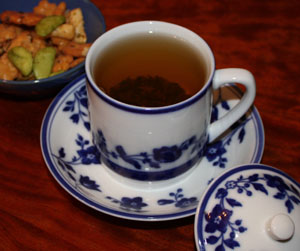Learning from the nuances of tea

a quiet cup of Vietnamese jasmine tea with sembei
Then it occurred to me, “Oh, if you blow on the tea leaves while you are drinking, they will sink down to the bottom by themselves.”
She is not a tea drinker, and certainly not a loose-tea-leaves-in-the bottom-of-the-cup type of tea drinker that I am. She blew on the leaves, and the problem (which I had not ever registered as a problem before, despite the many cups of tea we have shared over the years) was instantly solved.
I realized that this “trick” is a small detail or nuance that I learned to do without anyone ever telling me or teaching me, something that I learned to do subconsciously by watching all the other tea drinkers around me while I was growing up, something that if I had ever noticed enough to ask, they would have certainly thought I was crazy. Like the way no one ever thinks about personal space until someone invades it, there is a “feel” to the way we move about our lives that we do not think about until something goes awry.
I wish it were as easy as it looks on Star Trek. They can seamlessly infiltrate alien cultures and travel in time, with just minor changes in their appearance (either through temporary plastic surgery to create ridged foreheads or a sweat band to cover pointy ears). Other than a joke or two when a character misuses the word “groovy” in 1990’s Earth, they can always “pass.”
In real life, it is impossible for me to pleat a sari properly (despite living in Kathmandu and wearing a sari for four years), my mujadara and pulao always turn into Chinese fried rice (the spicing never quite right), my western table manners are stiff (even though I keep studying books on etiquette), my forays into the corporate world way too casual (too many years in nonprofits and universities). I do not have the right “feel.”
I am amazed at how immigrants do it. Even though I was born and raised in this country, and I speak the language fluently, there are so many nuances that I do not “get” that sometimes I feel I can never “pass.”
In graduate school, a new housemate once stared open-mouthed while I cut carrots. He said, “I’ve never seen anyone roll-cut carrots before. I’ve only read about it in cookbooks.” I did not know there was anything special about how I cut carrots, or that there was a name for it, or that anyone would ever write about it in a book. It was just the way I saw my mother and grandmother cut carrots, the way I thought all people cut carrots, but suddenly I felt like a museum piece. In that moment, I not only learned about my housemate’s culture, I also learned about my own culture...and we both changed.
Frances Kai-Hwa Wang is a second-generation Chinese American from California who now divides her time between Ann Arbor and the Big Island of Hawaii. She is editor of IMDiversity.com Asian American Village, lead multicultural contributor for AnnArbor.com, and a contributor for New America Media's Ethnoblog. She is a popular speaker on Asian Pacific American and multicultural issues. Check out her website at franceskaihwawang.com, her blog at franceskaihwawang.blogspot.com, and she can be reached at fkwang888@gmail.com.


Comments
Wolverine3660
Tue, Nov 17, 2009 : 6:24 p.m.
Frances-I think that in saying that Maj Hassan shot up Ft Hood due to mental illness, one has to deny a long trail of evidence that points otherwise.
Frances Kai-Hwa Wang
Tue, Nov 17, 2009 : 12:09 p.m.
America is and has always been a country of many cultures. Over time, some of these cultures have melded together to become what we now think of as the mainstream. The question for newer immigrants and their children is should they give up everything they bring in order to force themselves to fit into the old mainstream or should they add what they bring to the equation to create the new mainstream? Culture is always changing. Assimilation is an outdated goal. Think tossed salad instead. We are lucky that these days, there is room for both celebrating our heritage(s) and being fully American. The children and grandchildren and great grandchildren of immigrants (of many races), as well as adult transracial adoptees, are telling us that culture and heritage are important. My point is that it is not so easy. Sometimes it comes in the nuances between moments, in the pauses between words. And unfortunately, history shows us that just because a person does not self-identify with his/her ethnic background does not mean that others will not discriminate against that person for being just that. Finally, about the Fort Hood shooter (and the Virginia Tech shooter too), mental illness is a very big equalizer that does not care about race or culture, but who is to say that years of poor treatment, discrimination, and racism did not contribute to their unraveling? http://news.newamericamedia.org/news/view_article.html?article_id=895d1d6ea0faaf1ecabedde62b72a505 http://news.newamericamedia.org/news/view_article.html?article_id=16c0c7acd5472a80256c8b81e0502f91 --Frances Kai-Hwa Wang
Wolverine3660
Sun, Nov 15, 2009 : 9:32 p.m.
Well, I think folks who are too into this whole "multi-cultural" concept, are too hung up on being hyphenated Americans,and hence are unable to assimilate into the mainstream American culture. I refuse to be identified as an "Indian-American" or any other descriptor. I think the concept of multiculturalism has become a religion unto itself,and probably is more responsible for a bunch of social ills. Extreme case in point- the Ft Hood shooter wasnt punished or investigated by his military superiors, becasue they were intimidated by the climate of fear andintimidatoin that he excesses of multi-culturalism have wrough tupon our society. OK, I will shut upnow.